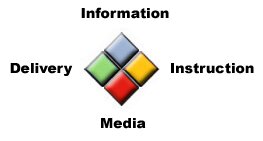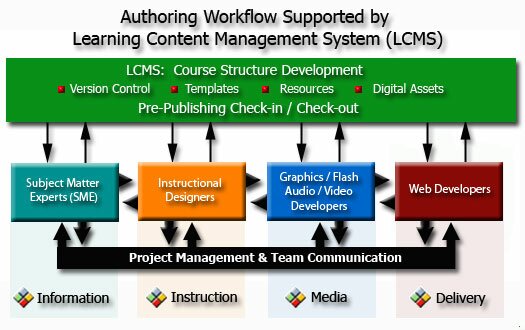|
 Design Process > Workflow Design Process > Workflow
Workflow
The Cognitive Design Process is a principle-based model, rather than a workflow procedure model. As such, one of its primary goals is to support E-Learning development (products and activities) by providing instructional design & evaluation criteria which can be applied in each workflow phase.
There are two main workflow procedure models which can benefit from using the Cognitive Design Process:
- Instructional System Development (ISD) , like ADDIE — has an extensive sequence of project management phases (analyze, design, develop, implement & evaluate)
- Rapid Prototyping — collapses the project management process to shorten the time-frame.
In both instances, the systematic focus on Information, Instruction, Media and Delivery System can be used as a unifying strategy.

The Traditional ISD Process
ADDIE moves through the phases of development — Analyze, Design, Develop, Implement, and Evaluate — guided by a project manager, with evaluation milestones marking the end of each phase. The process usually involves several people making contributions (i.e., planning, designing, developing, graphic / media production, programming, evaluating, supervising, etc.). So the workflow involves passing work-product and communication from one team member to another as the build proceeds. Structured sign-offs at the milestones implement an accountability management procedure.

What makes the traditional production process distinct are the following elements:
- There is a project plan with a project manager — guiding the build and the team through clearly defined phases, with accountability to sponsors, budget constraints, time constraints, end-user objectives, and a team process of communication and decision-making.
- There are distinct roles and responsibilities — project manager, designer, developer, graphic artist, programmer, IT web specialist, programmer, sponsors, upper management, etc. may all be involved. Even if one person plays more than one role, the role responsibility is kept in focus and not allowed to blur so that accountability is maintained.
- The project manager and the instructional designer drive evaluation as a team. The Cognitive Design criteria are used continuously for evaluation throughout the build. Decisions made in the planning stage, are executed in design, development and delivery stages. The build process is iterative — with continuous plan adjustments and product fixes being made with realism and pragmatism. Planning decisions and evaluation criteria (defining end-user benefit) must not be dismissed or inadvertently undermined by a team member that does not "buy in" to the process. Through the project manager and the instructional designer, the whole development team is accountable to the project objectives and unified in the value premise: "Instruction which does not teach, has no value."
- Risk: The main risk using traditional ISD is that it may be inappropriately complex, or too slow and cumbersome, for the project's scope and the available resources. Often the world of limited resources cannot support a complex or slow development process.
- Reward: The main benefit of traditional ISD process is that it provides a roadmap that works. It ensures that evaluation will be integral to each phase of instructional product development, and that the workflow process will have good structure.
The Cognitive Design Process model is used by the project manager and instructional designer to introduce an understanding of the end-user learning needs at the beginning of the planning stage — even before the team validates project scope and goals. The team must have a common vision of what the desired results and evaluation criteria are before they can validate their roles in the project. Focusing on "Information, Instruction, Media and Delivery System" is a tool to provide common language, shared values & vision, and consensus on the desired results and evaluation criteria of the end-product.
Rapid Prototyping
The rapid prototyping method of development collapses multiple phases of development into a single process. Typically, one key person is the driving force of the build, performing most of the roles of planning, design, development and evaluation. The goal is to get the first iteration of the instructional product built as quickly as possible, so that the evaluation team has a concrete product with which to work — rather than abstract concepts, drawings and hand-gestures.
The rapid production process is distinct because of the following elements:
- Time is of the essence — the waterfall method of phases is by-passed into one pragmatic rapid production phase to make a product immediately real and testable. End-users test the first version to validate and give feedback "what works and what doesn't." Often the project sponsors will be involved with the first-level of users to experience the instructional product and give usability feedback.
- There is usually one main designer-developer doing the work — In order to collapse the phases of workflow and shorten the timeframe, one key person must have adequate designer-developer skills and experience to drive the build successfully. The designer-developer must either be fluent in the subject-matter content, or obtain sufficient content information from the Subject Matter Experts (SMEs).
- Risk #1: A danger of rapid prototyping is that there will be inadequate planning and/or non-existent instructional design on the front-end of the project. If the key designer-developer lacks instructional design skills, then the end result — though quick — can lack instructional value. At the same time, if the designer-developer lacks development expertise and experience, then the build will be anything but rapid.
- Reward #1: If the designer-developer is able to build a viable prototype rapidly, then the ability to iteratively improve the product is made easier. Everyone involved in the project is now able to experience, test and give feedback on a working application.
- Final product quality is achieved through iterative improvement — the early versions give evaluators a concrete reality on which to give their input. One of the primary skills of the designer-developer in rapid prototyping is having the right mix of "pride of authorship" — to drive toward quality and quick execution— combined with "pride of teamwork" — to elicit feedback / constructive criticism and make use of the feedback once it is given. One technique for creating a first iteration for crucial feedback is to do a "wire frame" type of mockup, and only later after first level approval is affirmed to begin the larger investment in media production and programming.
- Risk #2: A key risk of rapid prototyping is that the evaluators may not be sensitive to the technical difficulties of making changes: They may ask for the impossible. They may be uneducated in design criteria of what is actually important versus unimportant. They may waste the developer's time and effort, and undermine quality. If the traditional model (i.e., development phases, milestones of evaluation, consensus-building and sign-off of sponsors at each phase) is by-passed; then project management can deteriorate into an un-ending "design by committee" process — that fails to be accountable to budget, time and manpower constraints. The strengths of the ADDIE process are missing. The end-result is not agile but slow, quality is lost, and the production team is demoralized.
- Reward #2: The phases of instructional development are never clean and tidy. Almost always there are major iterative changes happening between the milestones of define-design-develop. The rapid prototype method acknowledges this and capitalizes on it. The designer-developer doesn't usually report out to sponsors and project manager until s/he is ready to show a viable working instructional application — having worked through and solved most of the design-development issues.
The Cognitive Design Process model is used by the project manager & instructional designer as a tool to introduce evaluation criteria at the beginning of the project. The sponsors, and evaluation team, as well as the key designer-developer discuss the end-user learning needs at the beginning of the planning stage — as part of validating project scope and goals. Since the designer-developer "goes away, does the work" and then comes back with a prototype to show — ideally, all of the team will participate in building a common vision of what the desired results and evaluation criteria of the end-product will be. If there is not participation at this early stage, then there will not be genuine "buy-in" and consensus about the build later.
Focusing on "Information, Instruction, Media and Delivery System" is a heuristic device to focus the team with:
- a common language
- shared values & vision
- consensus on the desired results, and
- evaluation criteria for the stages of development and the end-product.
The plan for evaluation and feedback (especially based on Cognitive Design criteria) are used to ensure that there is agreement on direction and next steps. In this approach, the goal is to remove hidden agendas in the evaluation process and acknowledge the needs of an iterative build. The role of software support in the development process is described in the section called "LMS - LCMS". The following graphic illustrates how the members of a development team coordinate with each other during the development workflow.


|
|
 |
Workflow |
 |
|
|



